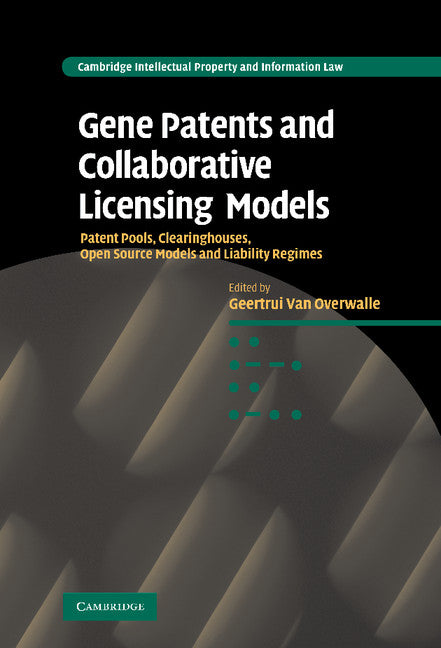Freshly Printed - allow 8 days lead
Couldn't load pickup availability
Gene Patents and Collaborative Licensing Models
Patent Pools, Clearinghouses, Open Source Models and Liability Regimes
An examination of legal measures which might be used to solve the problem of fragmentation of patents in genetics.
Geertrui van Overwalle (Edited by)
9780521896733, Cambridge University Press
Hardback, published 11 June 2009
516 pages
23.5 x 15.5 x 2.7 cm, 0.94 kg
"Van Overwalle has done an excellent job in creating a compilation that offers diverse perspectives on the feasibility and desirability of translating successful licensing schemes from other industries (electronics, software, entertainment) to biotechnology."
-J. Jonas Anderson,The IP Law Book Review
Concerns have been expressed that gene patents might result in restricted access to research and health care. The exponential growth of patents claiming human DNA sequences might result in patent thickets, royalty stacking and, ultimately, a 'tragedy of the anti-commons' in genetics. The essays in this book explore models designed to render patented genetic inventions accessible for further use in research, diagnosis or treatment. The models include patent pools, clearing house mechanisms, open source structures and liability regimes. They are analysed by scholars and practitioners in genetics, law, economics and philosophy. The volume looks beyond theoretical and scholarly analysis by conducting empirical investigation of existing examples of collaborative licensing models. Those models are examined from a theoretical perspective and tested in a set of operational cases. This combined approach is unique in its kind and prompts well founded and realistic solutions to problems in the current gene patent landscape.
Part I. Patent Pools: 1. Patent pooling for gene-based diagnostic testing: conceptual framework Birgit Verbeure
2. Case 1. The MPEG LA® licensing model. What problem does it solve in biopharma and genetics? Lawrence A. Horn
3. Case 2. IP fragmentation and patent pools: the SARS case Carmen E. Correa
4. Critical analysis of patent pools Jorge A. Goldstein
Part II. Clearing Houses: 5. Clearinghouse mechanisms in genetic diagnostics: conceptual framework Esther van Zimmeren
6. Case 3. The global biodiversity information facility. An example of an information clearinghouse James L. Edwards
7. Case 4. BirchBob: an example of a technology exchange clearing house Esther van Zimmeren and Dirk Avau
8. Case 5. The public intellectual property resource for agriculture. A standard license public sector clearinghouse for agricultural IP Alan B. Bennett and Sara Boettiger
9. Case 6. The science commons material transfer agreement project. A standard license clearing house? Thinh Nguyen
10. Case 7. The collective management of copyright and neighbouring rights. An example of a royalty collection clearing house Jan Corbet
11. Comment on the conceptual framework for a clearing house mechanism Michael Spence
Part III. Open Source: 12. Open source genetics: a conceptual framework Janet Hope
13. Case 8. CAMBIA's biological open source initiative (BiOS) Nele Berthels
14. Case 9. Diversity Arrays Technology Pty Ltd.: applying the open source philosophy in agriculture Andrzej Kilian
15. Critical commentary on 'open source' in the life sciences Arti K. Rai
16. Several kinds of 'should': the ethics of open source in life sciences innovation Antony Taubman
Part IV. Liability Regimes: 17. Pathways across the valley of death: novel intellectual property strategies for accelerated drug discovery Arti K. Rai, Jerome H. Reichman, Paul F. Uhlir and Colin Crossman
18. Case 10. The international treaty on plant genetic resources for food and agriculture: the standard material transfer agreement as implementation of a limited compensatory liability regime Victoria Henson-Apollonio
19. Critical analysis of property rules, liability rules and molecular futures: bargaining in the shadow of the cathedral Dan L. Burk
Part V. Different Perspectives: 20. Gene patents: from discovery to invention. A geneticist's view Gert Matthijs and Gert-Jan Van Ommen
21. 'Patent Tsunami' in the field of genetic diagnostics. A patent practitioner's view Jacques Warcoin
22. Gene patents and clearing models. Some comments from a competition law perspective Hanns Ullrich
23. Access to genetic patents and clearinghouse model. An economic perspective Reiko Aoki
24. The role of law, institutions and governance in facilitating access to the scientific research commons. A philosopher's perspective Tom Dedeurwaerdere
Part VI. Concluding Thoughts: 25. Of thickets, blocks and gaps: designing tools to resolve obstacles in the gene patents landscape Geertrui van Overwalle.
Subject Areas: Medical ethics & professional conduct [MBDC], Medical & healthcare law [LNTM], Intellectual property law [LNR]


